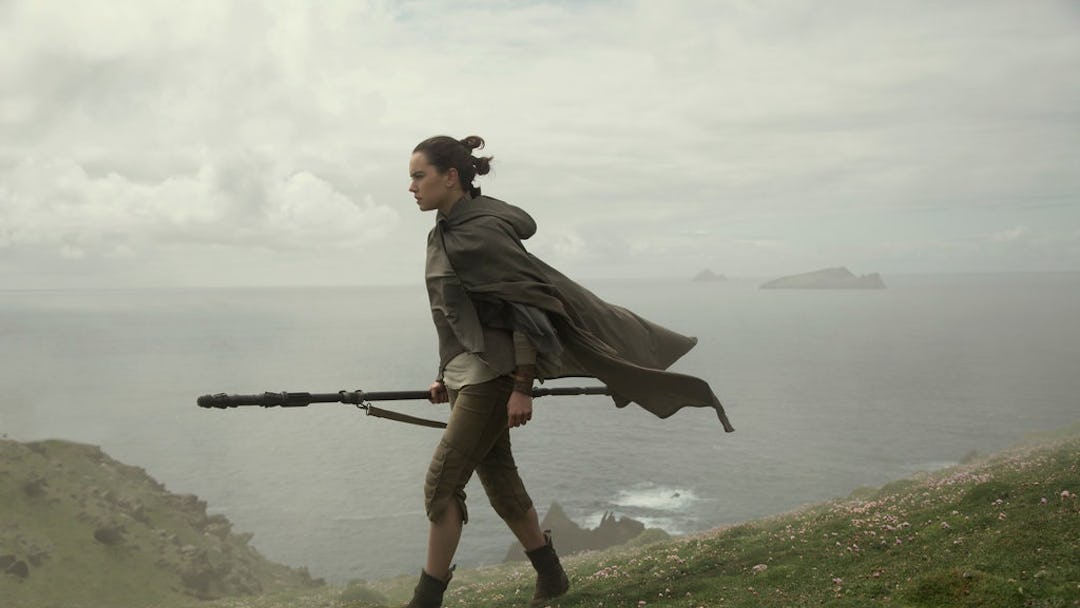What’s most striking about Rian Johnson’s Star Wars: The Last Jedi, first and foremost, is the speed of the damn thing. It’s the longest Star Wars movie to date, clocking in at around two and a half hours, but it doesn’t feel like it; it whizzes by, breathlessly, from the very first shot. And this is, after all, a franchise that famously began with the image of a giant spaceship cruising – crawling, really – past a locked-down camera; The Last Jedi begins with the camera plunging through space, hurtling towards a planet, whose sky soon fills with ships coming out of lightspeed, appearing intact like bubbles on an old episode of Pop-Up Video.
The entire movie runs at that clip, and with that intensity. Just as the first film in this sequel trilogy, 2015’s The Force Awakens closely followed the beats and style of the original 1977 installment, The Last Jedi takes its cues from that film’s follow-up, The Empire Strikes Back. But it doesn’t feel slavish in the way that the (still enjoyable) Force Awakens did; there are broad echoes and analogous plot points, but for the most part, Johnson (who also penned the script) was apparently free to move the franchise in new directions, with thrilling results.
As with Empire, the narrative is somewhat scattered. Rey (Daisy Ridley) is rediscovered on that nowhere island, at the moment she hands the lightsaber to Luke Skywalker (Mark Hamil), with a clever payoff. Rey’s battle with Kylo Ren (Adam Driver) has left him vulnerable, in the eyes of Supreme Leader Snoke (Andy Serkis), who admonishes him, “Alas, you’re no Vader. You’re just a child in a mask.” Poe (Oscar Isaac) and Finn (John Boyega) are trying to figure out how to save the last remnants of the Resistance, which is confined to a single starship, with Ren and the First Order in pursuit. And for reasons unclear, the Force has formed a kind of telekinetic connection between Ren and Rey, who is still trying to puzzle out her “place” in all this.
This sequel series is very much about the passing of batons, so it makes sense for Luke to move into the Yoda/Obi-Wan role of the wise old master/hermit. But he has no interest in that role, and Rey’s journey proves more complicated than his; there was never really a question, even when Vader explicitly posed it, of Luke succumbing to the Dark Side. But here, the push-pull between good and evil is made real – for both Rey and Ren.
The visualization of that inner conflict is one of the many moments in which Johnson gets to shine. “What do you see?” Luke asks her, and the answers are single words, ideas, seen in flash cuts – a look and style altogether unfamiliar to the Star Wars aesthetic. Yet it’s a welcome addition to the visual language of the series. He’s easily the most skilled filmmaker to ever helm one of these – it’s not even close – and it’s not just that the film has a surface beauty of its own. (Though it does; there’s a particular story turn that’s complemented with a tableaux as simultaneously gorgeous and thrilling as any in recent memory.) He’s aware of what we expect narratively from a Star Wars movie, and delights in subverting it.
The performers, too, come to play. The Last Jedi seems to find Domhnall Gleeson’s General Hux ridiculous in a way The Force Awakens did not, and it’s a better call; the actor really leans into the original trilogy’s sweaty, nefarious, pasty Brit villain thing. Benicio del Toro pops in briefly, in a turn that can best be summarized by Graham Chapman exclaiming “What an eccentric performance!” in Monty Python and the Holy Grail. The emotional heft of Carrie Fisher’s last appearance as Leia was at least partially unintentional, but is nonetheless affecting. And Hamill, never really trumpeted as the series’ finest actor, is wonderful – bitter and weary, in a way that (as with Ford in the previous film) bears the weight of carrying this iconic character around with him for four decades.
If The Last Jedi is too long – and maybe it is – it’s a question of abundance, of a writer/director so inspired by the richness of this world that he worked up a full plate of great ideas, and couldn’t bear to part with any of them. There are multiple sequences here that would’ve been the highlight of any single film; Johnson keeps bringing them on, finding new ways to dazzle us, move us, charm us. And while it’s a very funny movie (in that off-hand way the original films were, mostly via Han Solo) Johnson also treats this world as mythology, stories of gods and monsters, mortals and legends. Which is why its epilogue feels, counter-intuitively enough, like the most personal thing he’s ever made.
“Star Wars: The Last Jedi” opens Thursday night, like, literally everywhere.
